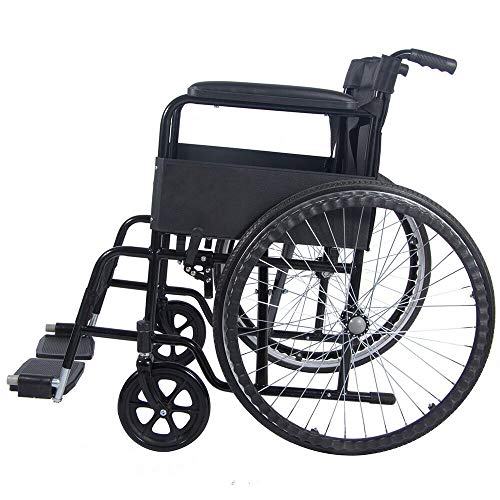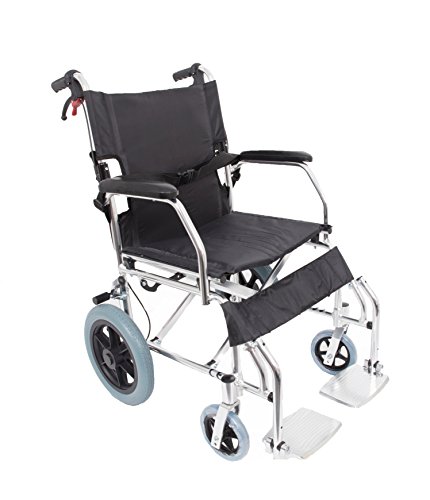The 10 Most Scariest Things About Folded Wheelchair
페이지 정보
작성자 Luella Franklin 댓글 0건 조회 11회 작성일 24-11-20 01:27본문
 Buying a Folded Wheelchair
Buying a Folded WheelchairFolding wheelchairs are perfect for those with small spaces or who are frequently traveling. This lets them take their wheelchair when they travel on holiday or in public transportation.
Start by turning off the power and disconnecting the power (if necessary). To open the chair, locate a safe place and remove any obstructions.
Seat and Handlebar
By lifting the lever on the side, the handlebars of a chair can be folded down. The user can lower the footplates and then swing them out and allow for standing transfers. This is also useful to place the chair under a table or desk. Some chairs have removable armrests to provide a cleaner appearance and make it easier to transport the chair in smaller vehicles.
When preparing to fold a wheelchair, the very first thing that a person should do is make sure that all locks and pins are secured. This will stop the chair from becoming disengaged during transport or causing damage to other things in the vehicle.
The majority of folding wheelchairs come with a cross-brace that collapses the frame when the sides are pulled together. However, there are other options to consider to collapse a wheelchair. These include scissor braces which fold the seat in half and "quick release axles" which allow the chair to fit into smaller spaces.
Before folding the wheelchair before folding it, the user must take the time to inspect it for signs of wear and tear and any adjustments that may be required. This will not only assist to prolong the life of the chair but also help prevent any unexpected problems that may occur during storage or transport.
Rigid Wheelchairs are made with a solid frame and can be folded up into a box to transport and store. They are typically made of aluminum or titanium and have an incredibly responsive feel because they don't move when the user pushes them. This could reduce the amount of energy one must expend. Some users have found it helpful to keep a higher level of control.
Before folding a rigid chair up the user should inspect it for signs of wear or tear. Also, they should determine whether any adjustments are required. The user will then be able to determine whether the footplates should be moved up or down and legrests are adjusted. It is crucial that the consumer consult their physical therapist before making any modifications to their wheelchair as it can impact their standing and transfer abilities.
Uprights
The uprights are short arms near the middle of the wheelchair frame, just below the point at which the seat connects with the backrest. They should be clearly marked as the "uprights" or "hinges," and are typically a bit higher than the armrests. It is important to properly identify and align these components of the wheelchair so that they will remain in the desired, folded position.
Wheelchairs that are able to be reduced in size for transport wheelchairs lightweight folding and storage are referred to as collapsible, or folding, wheelchairs. They are usually self-propelled, and come with the ability to fold backrests to reduce height, and a vertical 'X' frame to reduce width. The steerable wheels at the front and rear load wheels are mounted to brackets that pivot around upper and lower bars on the sidewalls. They also support the uprights.
When the chair is fully opened position, the links 61, 60, and 62 (see the figures. The links 61and 62 (see Figs. 2) of each slide are bent and the uprights 9 aren't in a position to move in relation to one another, even when the handles are raised. When the wheelchair is semi-folded, the uprights are moved forward by moving the slides on the rear and front axles respectively.
If the seat's depth is too short it can cause the wheelchair user to sit improperly and may not be able to relieve pressure on their thighs. This can lead to pressure sores. To check whether the seat is wide enough you need to measure the distance from the backside of the pelvis to the onset of the pre-seat bone shelf.
Once the wheelchair is correctly set, it needs to be secured and locked. This will help prevent injuries or accidental damage during transportation and storage. The wheelchair should be tested repeatedly to ensure that the locking mechanisms work in the way they should. This is crucial for those who have poor sensation in their thighs and toes, since an unintentional movement during storage or transport can result in serious injury. Once the chair is secure and locked and secured, it can be tucked away in its bag for travel or container.
Seat and Backrest
A wheelchair's seat and backrest are designed to provide stability, support, comfort and pressure relief. They also help reduce discomfort and prevent sores and pressure ulcers in those who spend a lot of time sitting. Wheelchair backrests and seat cushions are available in different sizes, shapes, and materials. For comfort, foam air cushions, or gel are available. Combination foam/gel and combination air cushion options offer an even more personalized solution that ensures stability and pressure distribution.
The right wheelchair for you depends on your personal requirements and the setting where you'll use the chair. Your doctor can guide you through this process and suggest the most suitable wheelchair for you.
Wheelchairs which fold are collapsible and can be smaller in size for storage or transport as well as travel. The majority of the wheelchairs are constructed with a "cross-brace" or the 'X" frame which allows them to fold in half when the sides are pushed together. Recently, a scissor-brace design has been developed to allow wheelchairs to fold on the back and front rather than the sides. This will save space.
Rigid frame wheelchairs do not fold and require a huge vehicle for transport. They are usually considered wheelchairs for young athletes and those who are interested in sports, however they can be used by anyone needing more stability than can be provided by folding chairs.
Carbon fibre is a lightweight folding travel wheelchair and durable material which is utilized in a variety of wheelchairs. The use of this material can however add costs. Some manufacturers have found that combining carbon fibre with titanium can help reduce costs.
Folding wheelchairs can be stored in a cupboard, storage room, or even the car's boot to transport patients to social gatherings, doctor's appointments, and family events. They can even be taken on holiday! Our engineers have designed a special solution that includes the "fold-forward backrest" that can lower the height of your wheelchair, making it smaller and thus easier to take in smaller airplane cargo holds.
Wheels
Wheels can be the most important part of a wheelchair, particularly for those who require mobility due to a medical condition that hinders their ability to walk or move on their own. For them, the quality of the wheels, tyres and casters can make a big difference in their daily lives. A set of wheels that is good will help them to get where they want to go, without feeling the bumps or rough edges of the road.
Wheels on a wheelchair are made of a tire (and hand rim or rim for manual chairs) spokes, mags, spokes, and hub. Depending on the type they are made from metal or plastic. A typical wheel can support up to 300 pounds and weighs about 7.5 pounds.
Storing and transporting a wheelchair is often difficult for some users, particularly if the chair's wheels aren't foldable wheelchair for elderly. Wheels that fold, like the Morph Wheel from Vitamins Design in London, are designed to change that. The wheel can be folded in on itself to take only 12 liters of space, just a fraction of the 22 liters that it takes up when it is open.
This model was created by the same person who invented bicycle wheels that fold. It has a central hub with six folding aluminum structures in place of traditional spokes. It also has a rim made of aluminum divided into six interlocking segments, and covered with a foam-filled tire. The result is a wheel approximately half the size of a standard 24 inches wheelchair one.
It's still a prototype however, the wheel has already attracted the attention of the disability community. It was a finalist for the Design Museum's Designs of the Year 2013 along with libraries in South London and a stool made by magnets.
 The designers are working to bring these wheels to the market as soon as is possible even though they're not yet available for most wheelchairs. The company relied on a focus group of wheelchair users to keep the design in top shape. A pair of Morph Wheels could cost about $950 and weigh more than other wheelchair wheels. They can fit into overhead bins for airlines, or in restricted car rental spaces. This makes travel much easier for wheelchair users.
The designers are working to bring these wheels to the market as soon as is possible even though they're not yet available for most wheelchairs. The company relied on a focus group of wheelchair users to keep the design in top shape. A pair of Morph Wheels could cost about $950 and weigh more than other wheelchair wheels. They can fit into overhead bins for airlines, or in restricted car rental spaces. This makes travel much easier for wheelchair users.댓글목록
등록된 댓글이 없습니다.